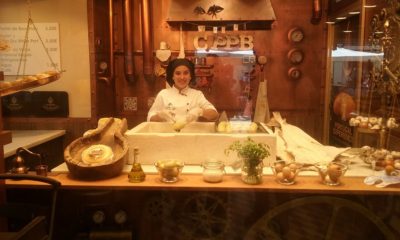
A Woman Preparing Codfish Cakes, a Portuguese Staple
Oct. 10: 4:30am came way too quickly but we got our tushes out the door by 4:45am. We didn’t know if we would end up taking a taxi or public transportation, as it depended on if there were taxis available at that time of day. Heading down to Gare Montparnasse, I spotted an available taxi (green light on top of the car) two blocks down a side street, so I hoofed it and ran up to him and we were good to go to Orly. Orly is a lot smaller than CDG and seems to be better suited for travel within Europe.
The cab driver was very engaging and told us about some of his travels in France and what areas he enjoys most about his country. He told us a story about Nicolas Fouquet who was Louis the XIV’s finance minister. Fouquet built himself a magnificent chateaux at Vaux-le-Vicomte about an hour from Paris. He invited Louis the XIV to the house warming party, where Louis became suspicious at Fouquet’s opulence. He suspected he was stealing from the royalty, so Louis imprisoned him in 1861 for the last nineteen years of his life. I bet Fouquet regretted ever throwing a housewarming party! And we got a new item for our TDL for future trips.
Anyway, 30 minutes later, we were dropped off at Orly where we efficiently checked in. Although once we got to the gate, the process became terribly inefficient. When we thought we were boarding, they got us all in a milling herd and made us measure our carry-on bags and let half of us know they are too big for carry on so that they had to be checked. This should have happened when we first checked in. In fact, when we checked in they had “cleared” our carry-ons. After saying almost all the so-called carry-ons had to be checked, they started calling up certain zones to board. We all formed a single file line, but there was no boarding. They just instructed us to shmush together while we stood in front of a closed door until the next absurd instructions arrived. It was sort of humorous, but even that was wearing thin, yet we were too tired to get verbally irate.
In a couple hours after we finally boarded, we touched down at the Lisbon airport. We went to the baggage claim and waited around until the cows came home when our bags finally came out the shoot. We were totally baffled as to why certain baggage claim conveyor belts were full of luggage and not moving. Anyway, different countries obviously handle things in different ways.
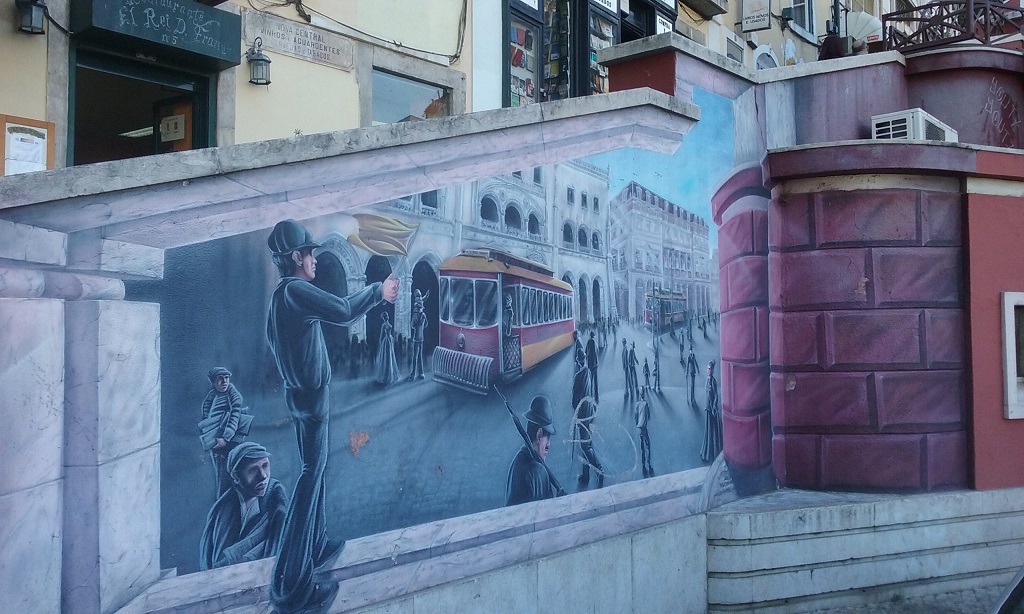
Lisbon Beckoned …
Dan had received an email a few days ago that there would be a taxi strike on the day we arrived and, if we wanted, they could set up a private ride for us. We accepted. Well, we couldn’t find the driver in the arrivals area, so I called our hotel, the Pousada de Lisboa, and the short story was that it took lots of phone calls and confusion and misdirected attempts before we eventually met up with the driver. With hindsight, we should have just taken the Metro, which would have deposited us a block from our hotel.. Anyway, not only were the taxi’s not providing service, but they were actively barricading streets at key intersections surrounding the airport and Lisbon itself. It took us a very long time to go six miles to the Pousada, because the city was in a state of gridlock. When we got to our hotel, we found out that the taxi strike was a statement against Uber. The traditional taxi drivers were trying to get the government to rescind permission that it had given Uber to operate.
Before I go on, I should mention one of the exciting things that we discovered in planning our trip to Portugal. We discovered the Pousadas de Portugal a chain of historic or traditional hotels. They are installed in historic buildings of some sort – castles, convents, sanatoriums, you name it. And they all offer elegant service at very reasonable prices, particularly if you are used to the prices in France and most of the rest of Western Europe. We planned to stay in them whenever we could in our tour through Portugal. The first stop was the Pousada de Lisboa, which is located in what was formerly the Ministry of Internal Affairs.
Once we arrived, we were received very graciously at the elegant pousada. David showed us to our room and explained how to work all the bells and whistles. The room has a feature where if you open the window, the AC shuts off – pretty cool. We knew we were in for an enjoyable stay.
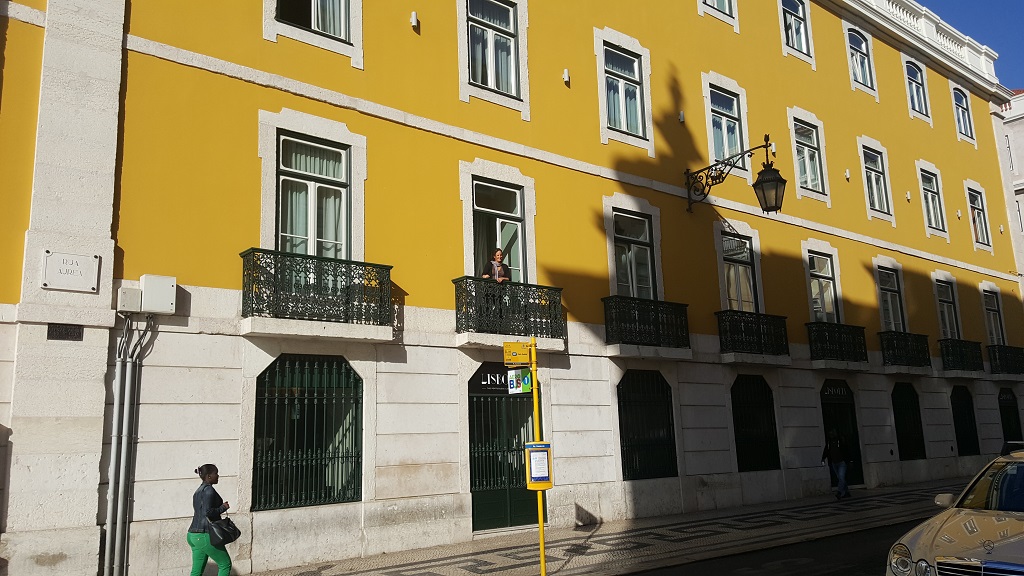
I Was Right at Home Once I Got to the Pousada
We were rather groggy but we didn’t want to give up a day of sightseeing, so we literally walked out the front door of our hotel into Lisbon’s main square, the Praça de Comércio and had some lunch at Can the Can, an outdoor café on the square, which has the interesting mission of raising canned food, canned fish in particular, to gourmet status. But I was not really focused on the canned goods. I was happier than a pig in poop to get some vegetables. I cannot figure out why, but France does not serve vegetables at their restaurants. I was truly craving veggies and so this hit the spot.
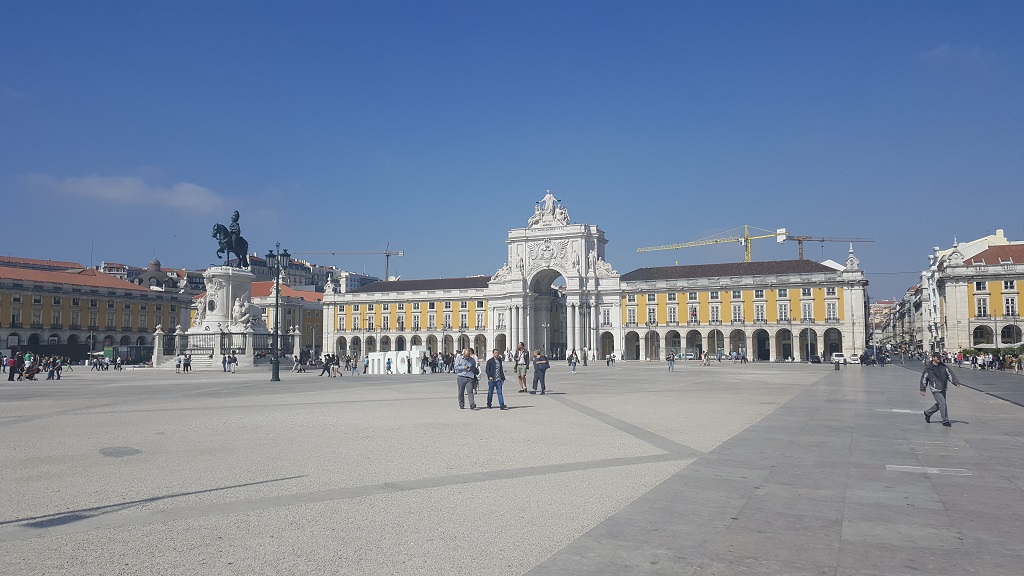
Praça do Comércio
The Praça do Comércio is anchored in the center by the monumental statue of King Jose I who sits on his horse symbolically crushing snakes in his path. It’s right on Tagus River, which flows out of the mountains and into the Atlantic. In Portugal’s days of discovery it was the site where traders would sell their wares collected from foreign countries. However, the current square, like so many things in Lisbon and all of Portugal, was totally rebuilt after the devastating earthquake of 1755. Today the Praca had its share of street musicians and people sunning themselves. Lisbon is further south than Paris and the weather was probably ten degrees warmer.
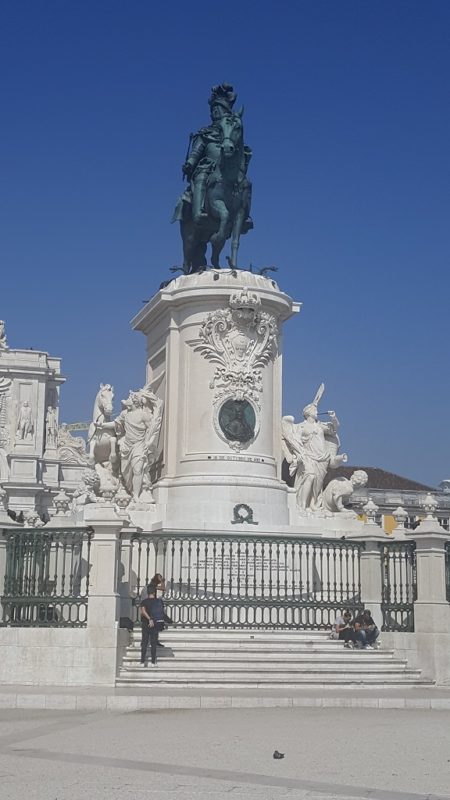
King Jose
On the north side of the Praça is the Arco da Rua Augusta. As we walked through the Arco, we went down pedestrian only Rua Augusta, which happens to be made of glazed tiles. It’s a sight in and of itself. It runs through the downtown area which is called Baixa and terminates at its north end at Rossio. This as well as the other pedestrian only streets in Lisbon had wall to wall cafes serving what looked like pretty unimpressive food to tourists, some pretty cool street artists, and a fair number of beggars.
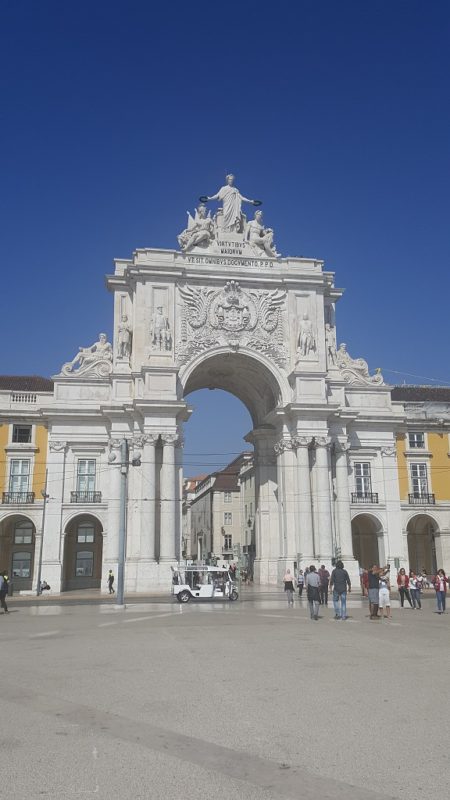
Arco da Rua Augusta
The tile buildings, the pastel colors, and the weathered Mediterranean looking facades all gave downtown Lisbon a unique charm. We soaked up this charm as we wandered the central city. The central areas of the city are pretty closely tied together, so it was easy to go a few blocks west up to the Chaido district. It too was filled with boutiques, clothing stores, and souvenir shops, but perhaps it had a bit more trendy feel than Baixa and Rossio. On a warm October day you can imagine that everyone was outside, filling the city with art and music.
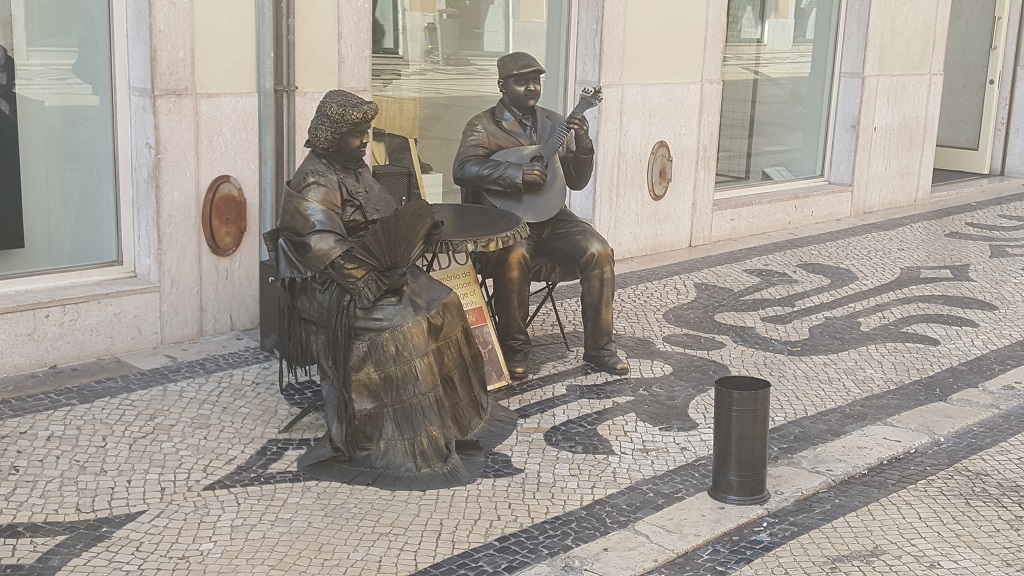
They Don’t Look Real, Click Here to Find Out
Our stroll placed us in a smaller praça and I suggested we sip some coffee outside. We were noticing that Lisbon has many small bars which are not much more than permanent kiosks. With our cappuccinos, we also tried a ginjinha – a local liqueur made from brandy soaked sour cherries. I had read about it beforehand and we spiked our cappuccinos with it. I have actually made a similar drink for years in my herbal and culinary exploration. Soaking fruit in liquor is an excellent way of preserving the fruit, as well as flavoring the liquor.
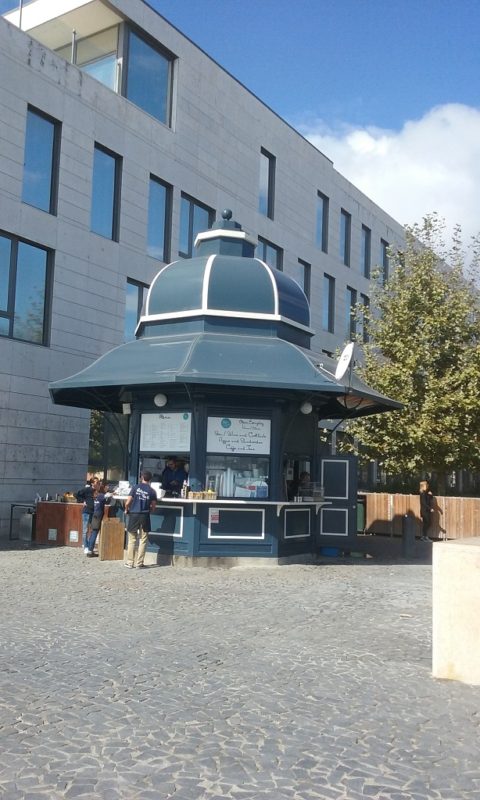
Kiosks Like This Are Abundant and Serve Drinks, Including Alcohol
After our ginjinha break, we wound our way down a different route and ended up in the Praça do Rossio, called Rossio for short. It too is constructed of glazed tiles. The pattern is wavelike and we sort of felt dizzy just looking at it, in a good way. From what we read, there is a buzz 24 hours a day there. Tourists, locals, hash sellers, artists, and any other walk of life are liable to be found. We remarked that when you build beautiful cool spaces, then beautiful and cool people come and do beautiful and cool things.
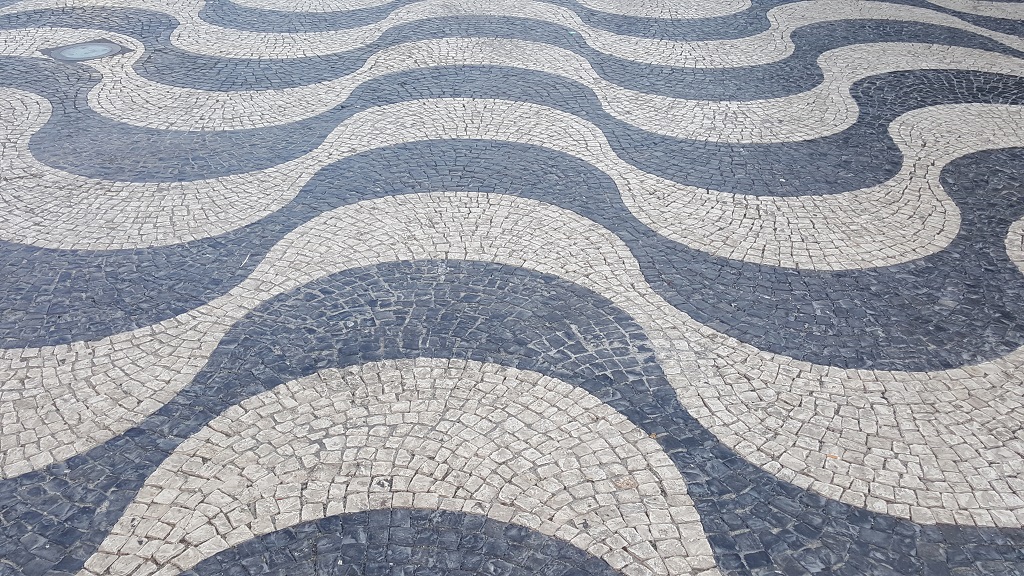
Rossio Can Make Your Head Spin
Something to note is that everyone speaks English here and most of them speak it very well. We anticipate that won’t be the case when we get to the rural areas, but in the city, they are bi-lingual, at the very least.
Our meander finally took us back to the pousada. I was thrilled it had a gym and pool for our disposal and I definitely wanted to take advantage of it during our stay. Dan caught up on some business and I sweated it out at the gym.
Having taken care of exercise and business, we were off to dinner at 100 Maneiras. We had read an interview in the LP with the chef and he sounded creative and not afraid to explore new food paradigms. We walked up the hill and wound through a back alley and finally arrived. En route, we had passed by 100 Manieras Bistro, which is his other restaurant, and where we had gotten further directions.
The atmosphere was cozy with rustic white painted wooden walls. A casual and friendly attitude permeated the space. We had the set tasting menu, where all of the dishes would be surprises. The food was excellent, it focused on a lot of fresh seafood, but what was most notable was the presentation.
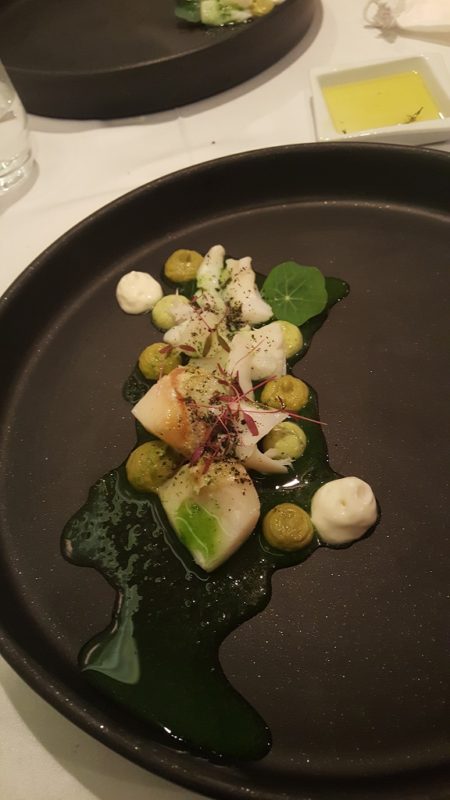
Presentation Is Paramount at 100 Manieras
We started with little strips of dried codfish attached to a miniature clothesline via tiny wooden clothespins, with some coriander and pepper sauces for dipping. We read later that the dish was intended to evoke the clothes hanging out of so many windows in Lisbon, particularly the Alfama District.
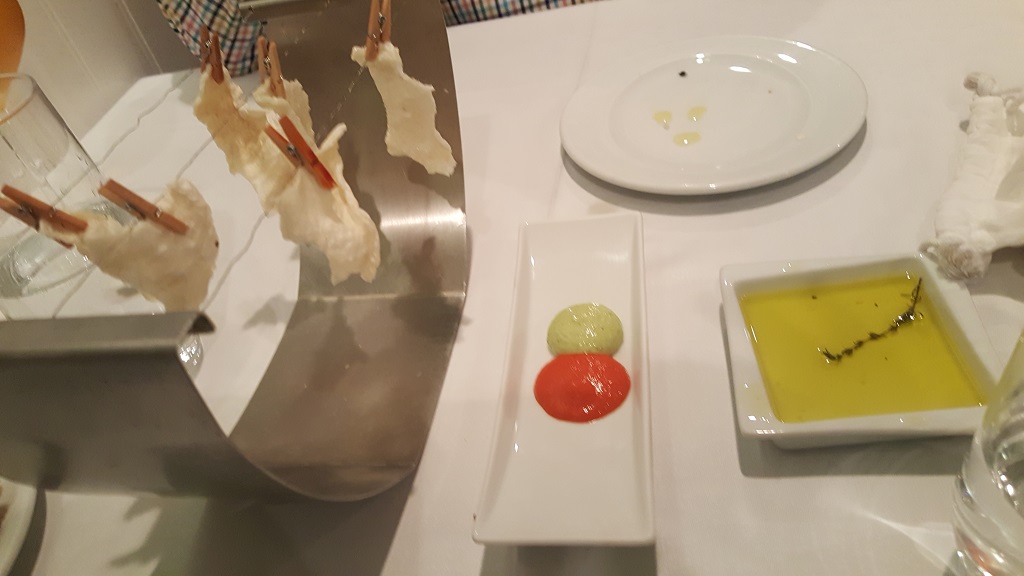
The Codfish Hangs on Clotheslines the Clothes Hang in the Alfama
After the clothesline presentation, almost every dish was served in a very heavy rock of some sort. One of them was on something that looked like a cobblestone. In fact, we asked the waiter if it were cobblestone, which he immediately denied, but we knew the truth. Other dishes were in something like a rock bowl and all of them were very heavy. It was like the chef wanted to balance the fish and water element with a strong earth presence.
Each dish was sumptuous and the one called “Perfect Skin” was particularly notable. It was layers with a piece of fried salmon skin, strips of red mullet, with a dollop of sardine pate and, for a dramatic effect, sprinkled with scarlet prawn dust. Look at what it sits on and you decide if it’s a cobblestone or not.
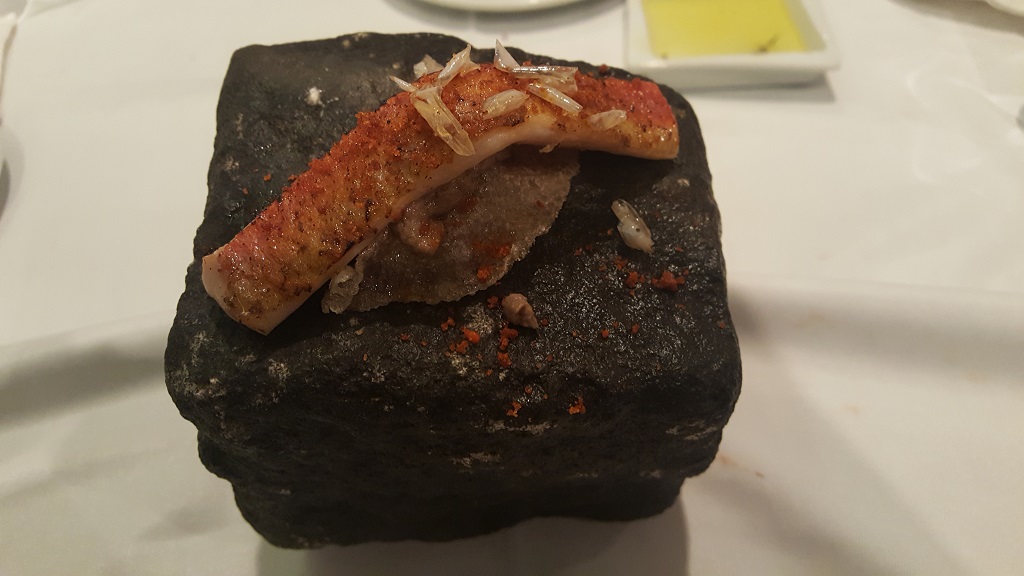
The “Perfect Skin”
The Talking Head was delicious and shows the Portuguese are not afraid of properly salting their food. It was a fried scarlet prawn head that was served opened up. And inside, it had been lined with dots of curry mayo, prawn olive oil and tartar sauce. You eat the whole thing, antennae and all (but not the rocks it rests upon).
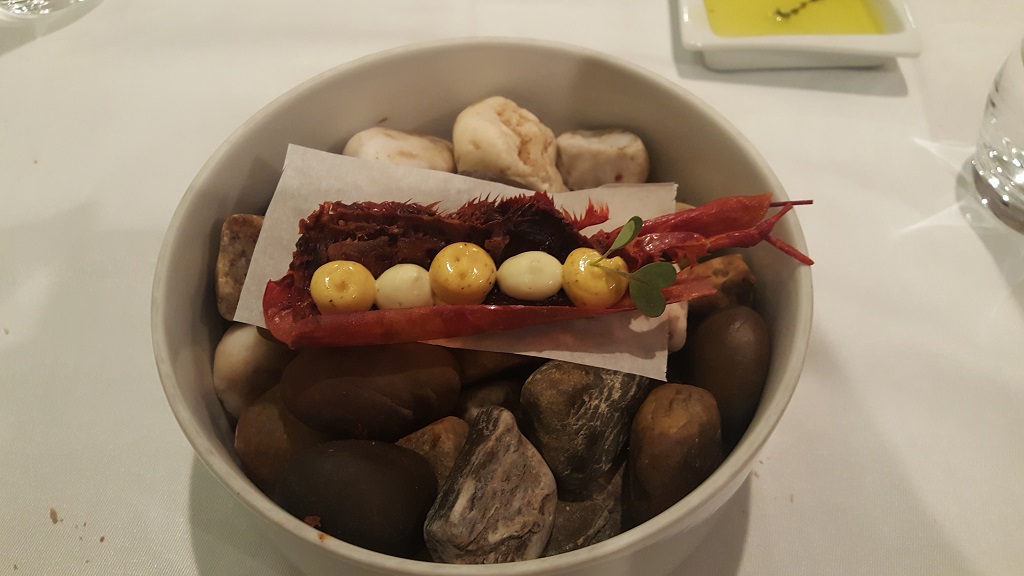
The Talking Head Was My Favorite
The deserts were equally creative, although they were not served on rocks. Nevertheless, the Islands in the Sun were, as the picture shows, well named. It is a banana cake soaked in rum sauce with São Jorge cheese and passion fruit. The São Jorge is a cow’s milk cheese from the Azores and has a buttery, earthy taste. The combination with the banana bread and passion fruit was delicious, particularly since it was not overly sweet.
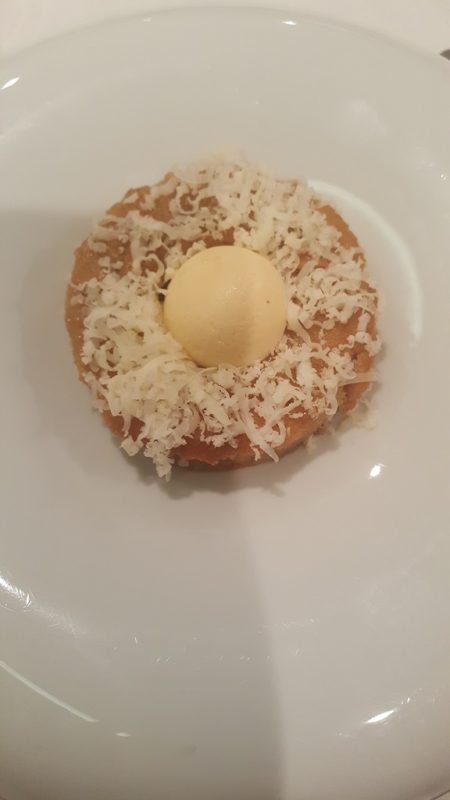
The Islands in the Sun
Since we were way up the hill, we took our time getting back down it, always eager to find new spots to investigate and explore. It seems Lisbon has roads that curve down and also some short cuts with staircases that cut more directly down to another street. We discovered one of many miradouros, Sao Pedro Alcantara. The miradouros are basically plazas that also serve as a lookout point. We could see the sweep of the city from the brightly lit Sao Jorge Castelo to the expansive Tagus River, called Rio Tajo in Portuguese. Eventually we found our way back to Lisboa Pousada. Dan and I were pretty sure we had landed in a special city.
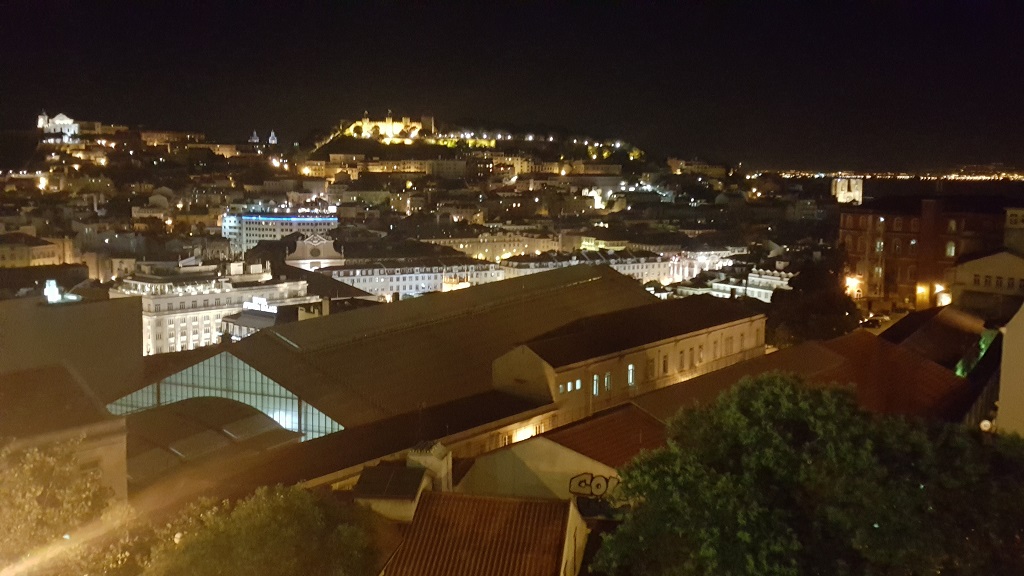
The View from São Pedro Alcantara

The Tagus from the Praço
